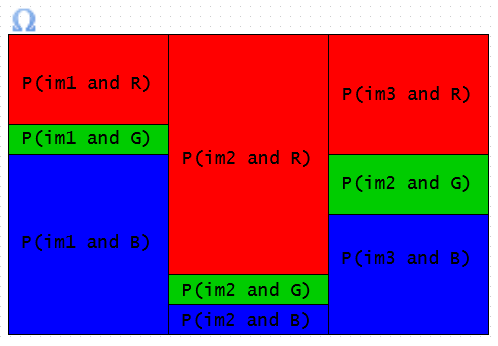Pixel = 'Pic'ture 'El'ement
Above is an RGB image with a pixel color distribution of roughly the following:
red = 30% green = 10% blue = 60%
Therefore, if we were to randomly sample a pixel color from the image ('im1'), we would have the following probabilities of sampling each color:
$ P(R|im_1) = .3 $ $ P(G|im_1) = .1 $ $ P(B|im_1) = .6 $
Given the following probabilities of two more RGB images with the same number of pixels as im1, solve (a), (b), and (c). (Note: we assume for this problem that pixels are sampled with replacement.)
$ P(R|im_1) = .3 $ $ P(R|im_2) = .8 $ $ P(R|im_3) = .4 $ $ P(G|im_1) = .1 $ $ P(G|im_2) = .1 $ $ P(G|im_3) = .2 $ } where R = red pixel sampled, etc, and im1 = pixel sampled is in image 1, etc. $ P(B|im_1) = .6 $ $ P(B|im_2) = .1 $ $ P(B|im_3) = .4 $
(a) Assuming that we have an equal probability of sampling a pixel from each image (ie $ P(im_1) = P(im_2) = P(im_3) = 1/3 $),
what is the probability that a sampled red pixel came from image 3?
(b) Now, assume that after the first pixel is sampled, our remaining pixel samples must come from the same image as the first
pixel. Given that we first sampled a red pixel, then a green and blue, what is the probability that we have been sampling
from image 1?
(c) Given the same {R,G,B} scenario as (b), and where pixels after the first must come from the same image, what is the
probability that our next (fourth) pixel sampled is red?
Solution
(a)
We have been asked to find P(im3|R):
$ P(im_3|R) = \frac{P(im_3 \cap R)}{P(R)} $ from conditional probability $ = \frac{P(im_3)P(R|im_3)}{P(R)} $ from Bayes' rule
Because the numerators of the previous equation are both given, we are only left to find P(R). Since the sample space is partitioned into disjoint subsets im1, im2, and im3 (see graphic below), we can use the law of total probability:
$ P(R) = \sum_{i=1}^{3} P(im_i)P(R|im_i) = \frac{1}{3}(.3 + .8 + .4) = .5 $
$ \therefore P(im_3|R) = \frac{(\frac{1}{3})(.4)}{.5} = \frac{.4}{1.5} $
(b)
We know that once an image has been sampled from, future color order does not matter since pixels are sampled with replacement. However, one might think that does matter for the first pixel (when the image number is not yet known). However, after performing the following calculations, it surprisingly turns out that order does not matter for this. (I don't know why.)
$ P(im_1|\{R,G,B\}) = \frac{P(im_1|R)P(\{G,B\}|im_1)}{P(\{R,G,B\})} $
The calculation of $ P(\{R,G,B\}) $ is defined similarly to the numerator. That is:
$ P(\{R,G,B\}) = \sum_{i=1}^{3} P(im_i|R)P(\{G,B\}|im_i) $
Since $ P(\{G,B\}|im_i) $ decomposes into $ P(G|im_i)P(B|im_i) $ due to independence, the only terms we are missing are P(im1|R) and P(im2|R). However, we calculated this for image 3 in (a). Using the same method:
$ P(im1|R) = \frac{(\frac{1}{3})(.3)}{.5} = \frac{.3}{1.5} $
$ P(im2|R) = \frac{(\frac{1}{3})(.8)}{.5} = \frac{.8}{1.5} $
$ \therefore P(im_1|\{R,G,B\}) = \frac{P(im_1|R)P(\{G,B\}|im_1)}{P(\{R,G,B\})} = \frac{(\frac{.3}{1.5})(.1)(.6)}{(\frac{1}{1.5})((.3)(.1)(.6) + (.8)(.1)(.1) + (.4)(.2)(.4))} = \frac{(.3)(.1)(.6)}{((.3)(.1)(.6) + (.8)(.1)(.1) + (.4)(.2)(.4))} \approx .31 $
(c)
Here we're looking for:
$ P(R|\{R,G,B\}) = P(R|im_1)P(im_1|\{R,G,B\}) + P(R|im_2)P(im_2|\{R,G,B\}) + P(R|im_3)P(im_3|\{R,G,B\}) $
$ = \frac{(.3)(.3)(.1)(.6)}{((.3)(.1)(.6) + (.8)(.1)(.1) + (.4)(.2)(.4))} + \frac{(.8)(.8)(.1)(.1)}{((.3)(.1)(.6) + (.8)(.1)(.1) + (.4)(.2)(.4))} + \frac{(.4)(.4)(.2)(.4)}{((.3)(.1)(.6) + (.8)(.1)(.1) + (.4)(.2)(.4))} $
$ \approx (.3)(.31) + (.8)(.14) + (.4)(.55) = .425 $
Notes:
If this problem is 'too long/difficult', just choose (a).
Although I'm confident in these answers, I don't understand why order does not matter for the calculation of (b).
(Perhaps my notation of the conditional probabilities is inaccurate, e.g. I'm not comfortable with events like {R,G,B}.)



